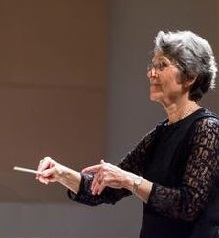In a mere 31 years, Schubert made significant contributions to the development of western music on many fronts. While “revolutionary” in some areas, such as the development of lieder and the exploration of harmonic relationships, he worked within the traditional forms of his time, managing to draw upon the rich heritage of Bach, Mozart and Beethoven in particular, yet expanding the harmonic vocabulary and placing his personal touch on conventional forms.
The compositions from 1827-28, his final two years of life, include the magnificent String Quintet in C, the last three piano sonatas, the song cycle Winterreise, and the Mass in E-flat you hear today. All are particularly rich, complex, profoundly moving, insightful – but the music must be allowed to speak for itself; adjectives fail to convey or even suggest the full emotional impact of the works themselves.
This Mass, the last of six he composed, departs from more traditional treatments in several ways. First, it is a “solemn” mass, large and ceremonial in concept and treatment. Clearly he was familiar with Beethoven’s Missa Solemnis. Some of the E-flat’s special features include the fact that it is primarily a choral mass, with full symphonic accompaniment. No solo arias exist, though Schubert does create one of his most beautiful movements for the unusual combination of soloists (two tenors and a soprano) in the “Et Incarnatus est”. The orchestra lacks two flutes, their lightness replaced by the prominence of the three trombones, which lend a somber, dark hue to many passages. The timpani (as in Beethoven) plays a significant role, including several solo passages and even gets the last word as the final moving voice at the end of the work. The chorus has several a cappella sections; dynamics range from very soft to very loud. As always in Schubert, contrasting keys are used to startling effect, both in climactic and intimate passages. The two large fugues (Cum sancto spiritu and Et vitam venturi) are true marathons – long, complex, demanding, full of tight counterpoint where each voice part is on a individual journey, but the collective group moves, often chromatically, into unknown territory, only to emerge at the end, thoroughly tested and proven worthy of the challenging journey.
The opening Kyrie’s long, fluid lines suggests great breadth as the chorus moves in homophonic agreement, with no hint of the contrapuntal intricacies to come.
The Gloria explodes with choral energy, answered by bright strings, brass and winds. This movement is a study in contrasts, including different vocal and instrumental pairings. The Domine Deus introduces C-minor with a strong, foreboding statement by trombones and horns. This will be heard again and developed further in the concluding Agnus Dei. Again, great contrasts exist as the chorus quietly pleads for mercy. A brief return to the opening jubilation (Quoniam) leads to the first of the strikingly chromatic and complex fugues – Cum sancto spiritu. Enjoy the ride!
A solo timpani opens the Credo, in which the chorus alternates between quiet, homophonic statements and more exuberant, imitative expressions of faith, leading to the beautiful “Et incarnatus”, tenderly set for two tenors and soprano. As if in horror at the thought, the chorus’ whispered “Crucifixus” develops into a full-fledged shriek of disbelief. Accompanying tremolo strings intensify the brutal juxtaposition of life and death. Once again the timpani leads to the dramatic description of the resurrection. The longest and most complex fugue (Et vitam venture saeculi, Amen), comes pretty close to depicting life everlasting, and explores hitherto unvisited caves of harmonic juxtaposition.
Usually the Sanctus is set in a major key – and so Schubert begins – but by the second entrance, he has once again introduced another color, followed by other unexpected blocks of sound. These outbursts are balanced by a sprightly Osanna which almost sounds like Bach or Handel, but ends, yet again, with Schubert’s own surprising little coda.
In the charming Benedictus, a solo quartet spins a typical Schubertian melody, sharing it with the chorus and various orchestral sections. The Osanna dances by once again to conclude the movement.
Perhaps the most profound movement is the Agnus Dei, with its return to c-minor and strong theme reminiscent of the Dies Irae, presented starkly by the trombones and horns. The chorus develops this subject briefly as a double fugue, followed by a simple, human cry for mercy (Miserere nobis.) The same pattern is repeated three times before leading to a gentle, rocking Dona nobis pacem. The Agnus Dei conveys the inexorable crush of cold, unfeeling Fate; the Dona nobis offers sweet consolation and the gentle warmth of human touch. While the movement settles in the glow of E-flat, Schubert introduces a shadow in the very final cadence–and in the concluding timpani strokes that accompany the ultimate curtain.
Barbara Jones

